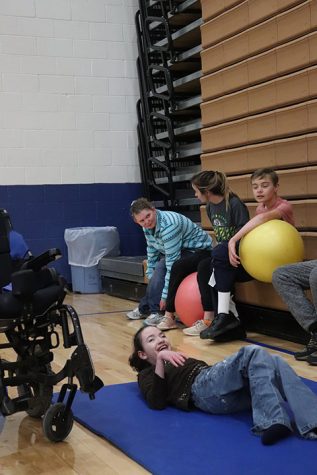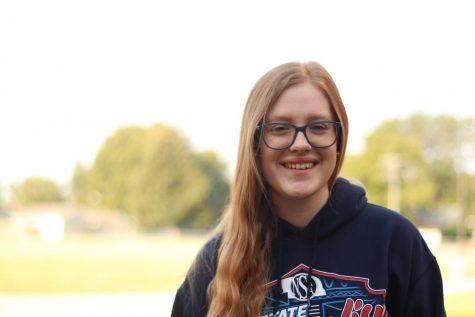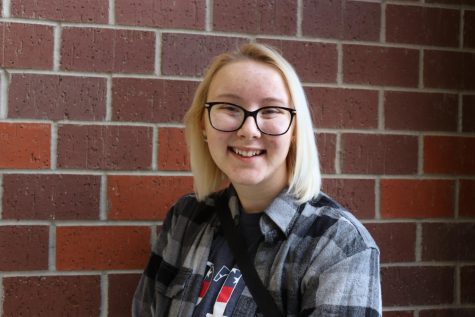Missing the goal
Students with multiple and severe disabilities are attending regular education gym but the class still needs some work
In 2004, the Individuals with Disabilities Education Improvement Act (IDEA) required schools to mandate equity, accountability and excellence in education for children with disabilities. Students with disabilities at North Platte High have been taking regular education classes for many years (for example, foods, art, social studies, small engines). However, in October, students with multiple and severe disabilities, like those in wheelchairs, stopped taking adaptive physical education, and were integrated into rec sports, a class that teaches fitness, weights and recreational games.
We think an inclusive setting is a good idea and has great potential. Students with multiple and severe disabilities and regular education students alike, can both greatly benefit from each other. Interaction between these peers help teach important social skills to both parties.
However, we have concerns.
It is unclear to us why the district chose to integrate students with multiple and severe disabilities into a gym class rather than a class with less intense activity. To us, the safety of students seems like it could be at risk here. In a non-inclusive class with regular education students, students get hurt pretty regularly. From The Bulldogger staff, one of us has slipped on a ball and landed on our face. Another one has gotten a concussion while playing badminton. One of us has been escorted out of the school in a wheelchair after running the mile and having an asthma/panic attack. One of us has almost lost our sight because our glasses broke while competing in an obstacle course. We’re worried. Accidents can happen in any class, but injuries can be so much more detrimental to a student with severe disabilities. What if the falls and the balls and the concussions and the asthma happen to someone who’s more physically delicate?
While watching the inclusive PE class, we observed some worrisome behaviors, such as a student laying down in the middle of an active basketball game. Another time, a student with epilepsy and cerebral palsy was hit in the head with an exercise ball. This left some questions in our minds.
The students with multiple and severe disabilities sit as they get ready to start regular education gym class.
Students with multiple and severe disabilities need extra support from their teachers, and if the regular education teachers haven’t been trained on the most successful way to tend to all of their students, doesn’t that put some students at risk? We think it does. If a regular education teacher is giving more attention and support to students with multiple and severe disabilities, are they able to give an adequate amount to their regular education students? In the instance of the injury of a student with multiple and severe disabilities, do the regular education teachers know how to properly handle those situations? Are they even allowed to help? We’re under the impression that the answer is no.
Through several conversations with multiple people about the planning and training taken to develop the inclusive gym class, it’s clear to us that there was slim to none. “We’re learning on the fly,” and “Until we actually did it for the first time, we didn’t really know how it was going to work,” were just a few of the things we heard about the preparations for this class. This lack of forethought is another cause for concern.
Another thing to consider is whether the students were prepared beforehand? While all students can learn from each other, it seems important that both regular education students and students with multiple and severe disabilities be better informed about such a substantial change. Even though the special education teachers assess each of their student’s behavior daily before deciding whether to hold class in the gym with the regular education students, there is still a lot of room for random accidents by both regular education students and students with significant disabilities.
These all seem like some serious risks for a class that’s hardly inclusive anyways. Nearly one-third of the gym is dedicated to the students with multiple and severe disabilities, while the other two-thirds are reserved for the regular education students. With a few exceptions, the students aren’t really working together inclusively during their activities. According to “Brain-Friendly Strategies for the Inclusion Classroom,” author Judy Willis says, “Full inclusion of all students–even those with severe disabilities–in general education classrooms doesn’t mean [special education] students work separately with their aide while the rest of the class does other work. Truly inclusive classrooms integrate and coordinate specialized school support programs with the general education program.” So at NPHS, does inclusion mean the same class or the same class-room?
To reiterate, we think an inclusive setting in school is potentially a great idea. As the district rewrites the physical education curriculum this year, we strongly encourage them to consider adding a gym class that it less competitive, less intense, and less dangerous, while still providing physical activity and equal opportunity for all students. In this elective PE class, students with multiple and severe disabilities could join and have adaptations, along with more research and planning, which would make it safer for all students. Another thing that could be successful would be instead of having all students with multiple and severe disabilities attend one gym class together, have them spread out and attend a few different classes. This way, there would only be few students with multiple and severe disabilities per inclusive P.E. class.
We do hope that the push for an inclusive setting at North Platte High continues. It’s important for students to understand that they will work with and live around people with disabilities their whole life, not just in school. An inclusive setting throughout school does help prepare all students for that. But more importantly, we also hope that the district reconsiders placing students with multiple and severe disabilities into any highly-intense, competitive gym class, where the safety of all students could potentially be in question. We do want all students in all of our classes, but Rec Sports was not the place to start for students with multiple and severe disabilities.

Haley McKain 2018
Co-Editor in Chief
A little bit about me
I cry all the time. Not always in a bad way or anything, but when I’m mad, sad, and especially...


